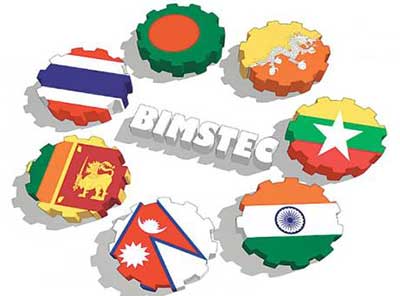Date : 25/12/2023
Relevance: GS Paper 2- International Relations - Policies affecting India’s interest
Keywords: The Bay of Bengal region, Act East Policy, Free Trade Agreement (FTA), SAARC, 'Indo-Pacific' region,
Context-
India has recently assigned a senior diplomat to the role of the fourth Secretary-General of the Bay of Bengal Initiative for Multi-Sectoral Technical and Economic Cooperation (BIMSTEC), emphasizing the commitment to accelerate regional cooperation in the organization. BIMSTEC, a multilateral regional organization, aims to foster shared growth and collaboration among littoral and adjacent countries in the Bay of Bengal region.
BIMSTEC Overview
- Origin and Membership: BIMSTEC originated as BIST-EC in June 1997 with the adoption of the Bangkok Declaration, comprising Bangladesh, India, Sri Lanka, and Thailand. Myanmar joined later in 1997, transforming it into BIMST-EC. The organization assumed its current form in 2004 with the inclusion of Nepal and Bhutan.
- Strength: Encompassing Bangladesh, Bhutan, India, Myanmar, Nepal, Sri Lanka, and Thailand, the BIMSTEC region hosts 22% of the world's population (1.68 billion people) and boasts a combined GDP of US$3.697 trillion per year.
- Working Mechanism: BIMSTEC's policy-making involves summits every two years and ministerial meetings for trade and economic affairs annually. Additionally, operational meetings of senior officials are held biannually to monitor group activities.
Significance of BIMSTEC
- Need for Formation: The Bay of Bengal region, historically integrated, witnessed a decline in cohesion post-independence. BIMSTEC's formation aimed to revive connectivity and shared interests among member countries.
- Acting as a Bridge: BIMSTEC serves as a direct link between South Asian and Southeast Asian countries, reinforcing relations and fostering intra-regional collaboration.
- Sector-Driven Approach: Unlike other regional groupings, BIMSTEC adopts a sector-driven model, dividing goals and areas of cooperation among members. India, for instance, oversees areas like transportation, tourism, counter-terrorism, disaster management, and energy.
- Alternative to SAARC: With the progress of the South Asian Association for Regional Cooperation (SAARC) stalled due to geopolitical issues, BIMSTEC emerged as an alternative platform for regional cooperation.
India and BIMSTEC
- Importance for India: BIMSTEC aligns with India's 'Act East' policy, promoting greater regional cooperation in Southeast Asia. It supports India's goal of gaining trade and security prominence in the Indian Ocean and aligns with the concept of the 'Indo-Pacific' region, a focus of Quad countries.
- India's Efforts: India has actively contributed to BIMSTEC's progress, establishing the BIMSTEC Energy Centre in Bengaluru and the BIMSTEC Business Council. These initiatives aim to promote regional trade, create free-trade and power grid interconnectivity agreements, and develop a master plan for transport connectivity in the Bay of Bengal region.
Challenges Faced by BIMSTEC
- Sluggish Pace: One major challenge is the perceived lack of efficiency and sluggish progress in BIMSTEC's activities. Inconsistencies in holding policy-making and operational meetings raise concerns.
- Inadequate Assistance: The BIMSTEC secretariat faces challenges related to insufficient financial and manpower assistance for its operational activities.
- Trade Challenges: India's trade with BIMSTEC countries, as a percentage of its total foreign trade, has decreased over the years. Inter-regional trade within BIMSTEC countries varies, with member countries often importing goods from non-member countries.
- Absence of Connected Coastal Ecosystem: BIMSTEC members are yet to establish a shared and lucrative coastal shipment ecosystem. Challenges include the frequent detention of fishermen crossing territorial borders.
- Challenges Faced by Members: Recent challenges include strained Bangladesh-Myanmar relations over the Rohingya refugee crisis, the India-Nepal border issue, and the political situation in Myanmar.
Future Suggestions and the Way Ahead
To drive meaningful interactions among member states, a stronger BIMSTEC secretariat is essential. This would address challenges related to efficiency, coordination, and implementation of agreed-upon initiatives. Moving ahead, the way forward for the BIMSTEC region involves leveraging its inherent diversity by fostering regional synergies and optimizing available resources. This approach is essential for cultivating a more robust and dynamic BIMSTEC. In navigating the complex landscape of domestic and geopolitical factors, member states must engage in sustained multilateral discussions at both bilateral and group levels. These discussions are crucial to prevent challenges like the Rohingya crisis from hindering the seamless delivery of economic and security outcomes. India, in particular, needs to maintain consistent political engagement with partners such as Nepal, Sri Lanka, and Bangladesh, ensuring that domestic political issues do not adversely affect collaborative working relationships.
To fulfill India's vision of enhancing trade connectivity within the grouping, the implementation of a Free Trade Agreement (FTA), especially among maritime resource-rich members like Myanmar and Sri Lanka, could yield substantial benefits for all participants. The establishment of a 'coastal shipping ecosystem' and an interconnected electricity grid, aligned with the adopted Master Plan for Transport Connectivity, has the potential to significantly amplify intraregional trade and economic ties. It is imperative for BIMSTEC to secure additional funding and prioritize the timely implementation of projects to realize these opportunities fully.
As the torchbearer of the revived grouping, India must assume a leadership role in addressing any concerns among smaller members regarding power imbalances. Facilitating greater cross-border connectivity and fostering the flow of investments by reducing barriers to the movement of people and goods are key responsibilities for India. Notably, during the summit, India stood out by offering additional funding to the Secretariat and supporting the Secretary General's proposal to establish an Eminent Persons Group (EPG) for creating a vision document. Other member countries should follow suit by translating their commitments into tangible actions.
Looking ahead, BIMSTEC should diversify its focus by exploring new areas such as the blue economy and the digital economy. Additionally, emphasizing the promotion of sectors related to sustainable development will contribute to the region's overall progress. By collectively embracing these strategic measures, the BIMSTEC region can chart a path toward enhanced cooperation and prosperity.
Conclusion
While BIMSTEC holds immense potential as a regional cooperation platform, addressing challenges such as a sluggish pace, inadequate assistance, and trade imbalances is crucial for its success. India's active involvement and initiatives, coupled with collective efforts from all member countries, will determine the organization's ability to fulfill its objectives and contribute to regional growth and stability.
Probable Questions for UPSC mains Exam-
- How has India actively contributed to the progress of BIMSTEC, and what initiatives has it undertaken to enhance regional trade and connectivity? (10 Marks, 150 Words)
- In what ways does BIMSTEC differ from other regional groupings, and what challenges does the organization face in achieving its goals of shared growth and cooperation in the Bay of Bengal region? (15 Marks, 250 Words)
Source- The Hindu Business Line























